Crawling Back: Amazing Spider-Man #2 Review (The Sinister Six, Part 1)
Spidey's second-ever issue showcases the ever-developing nature of his world under Lee and Ditko
—by Nathan on September 14, 2023—

I have, within the last year-and-a-half, examined three pulse-pounding appearances of the sinister sextet known as the, uh, the Sinister Six. Guess I gave that away. Originally introduced by Stan Lee and Steve Ditko in Amazing Spider-Man Annual #1, the team came back together 26 years later, again under the watchful gaze of Doctor Otto "Octopus" Octavius (even if the roster was a little different); less than two years after their reunion, the team rose again, initially against the Doc but eventually bandying with him to attempt total world domination.
Bwa-ha-ha.
Since reviewing their Erik Larsen-led revival, I’ve wanted to dive back into time and pluck from history each member’s first appearance. All six villains are creations of Stan Lee and Steve Ditko, forming a good portion of the bedrock that is Spidey’s recurring rogues gallery. Each villain fought Spidey at least once on their own before their first team-up…where, strangely, they each fought Spidey…on their own. Yeah. But, hey, it’s still my single favorite issue of any comic ever, so I’m gonna let that slide.
First on the docket: in Spidey’s second Amazing Spider-Man issue ever published, the red-and-blue baddie buster takes on the winged octogenarian (okay, I made that up–I have no idea how old he is) known as the Vulture...and then, if fighting one retirement home reject wasn’t enough, he goes up against a second old-timer.
Maybe Jameson has a point about this guy being a menace.
"Duel to the Death with the Vulture"/"The Uncanny Threat of the Terrible Tinkerer"
Writer: Stan Lee
Penciler: Steve Ditko
Inker: Steve Ditko
Colorist: Sam Rosen
Letterers: John Duffy, Artie Simek
Issue: Amazing Spider-Man #2
Issue Publication Date: May 1963

The Vulture’s first appearance, as detailed by Lee and Ditko, is certainly important, marking the introduction of the second supervillain Spidey ever battled (the first being the Chameleon, introduced the previous issue), particularly one who, despite his aged appearance, remains a consistent member of Spidey’s rogues gallery. He’s a classic criminal, and despite changes in appearance (he was once temporarily de-aged) and the rise of a couple of copycats (like Blackie Drago, the Vulturions, and Jimmy Natale), Adrian Toomes has risen above all challenges and challengers to remain a mainstay. Can’t keep a good villain named after a predacious bird of prey down, as the kids say.
And we’ll discuss the Vulture in a bit. But I want to first focus on the world around him.
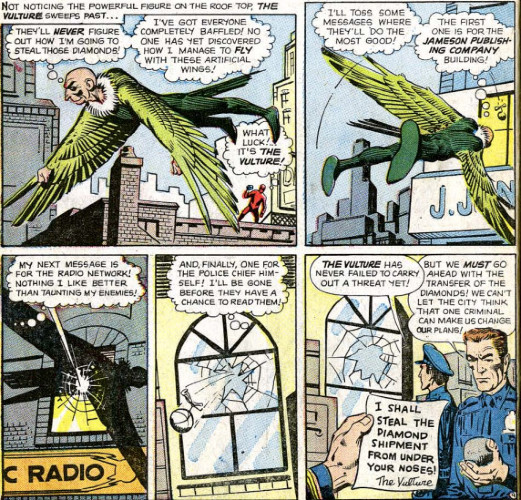
Stan Lee and Steve Ditko created, for many, the definitive Amazing Spider-Man run. I personally enjoy a few writers more than Lee, but you cannot discount how fundamental the first 38 issues of Amazing Spider-Man are to the series and why, to this day, despite Lee’s trademark verbose and clunky dialogue, they remain integral and a perfect jumping-on point for the character’s history. Just think about how, over sixty years, a good chunk of Spidey’s supporting cast and adversaries have stuck around, how largely unchanged his origin has remained, how his life and career choices build from the bedrock laid by Lee and Ditko. Spidey is still so continually influenced by those early issues that you’d be forgiven for thinking Lee and Ditko plotted this all from the start.
And the wonder of this issue is how it showcases the opposite.
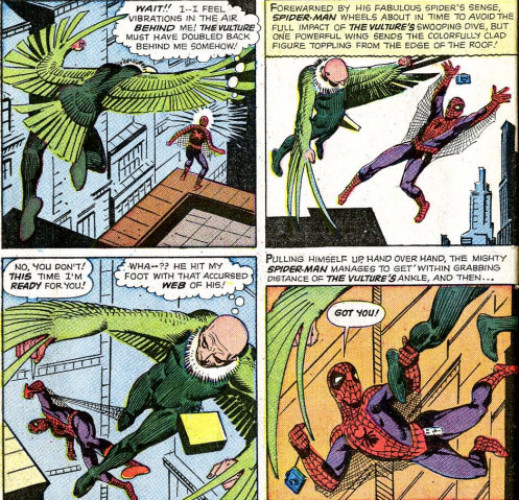
Though Spidey’s ongoing saga has treated several elements of his early days as surprisingly rigid, we find flexibility within this issue, differences between the Spider-Man of today and the Spider-Man of May 1963…and even differences between the Spider-Man of May 1963 and the Spider-Man of ASM #38, Ditko’s last issue. You don’t put ASM #2 down convinced Lee and Ditko had a complete concept of just who Peter Parker was or of the world where he existed. And all you need to do is observe the details.
Peter refers to Flash Thompson as "Moose" in an early panel, and the delivery is written to insinuate Peter’s using a nickname, not insulting the bully’s big head or other en-deer-ing qualities. It’s not "you moose" like he would say "you moron." Just "Moose." And, yet, in the second story, Peter calls Flash by his name. Just "Flash." Stan Lee’s scripts were not without their mistakes–in the very next issue (which I intend on reviewing), ASM #3, Doctor Octopus calls Spidey "Super-Man," an error which has lived on in perpetual infamy–and this feels like a genuine error. One might consider that Lee was simply toying with another name, but the character was called Flash later in the issue as well as in Amazing Fantasy #15. Maybe "Moose" was the intended name at one point, and Lee got his notes mixed up. Elsewhere, J Jonah Jameson owns his own publishing company, Jameson Publishing, which produces NOW Magazine, when he was originally introduced in ASM #1 as the publisher of The Daily Bugle. Another slip of the pen, perhaps?
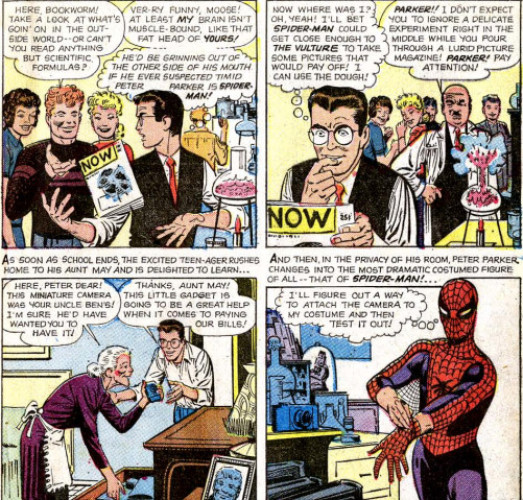
Other details, when scrutinized, can be chalked up to Spidey’s continual narrative development rather than outright errors. Liz Allan, initially downright hostile to Peter Parker in AF #15 and ASM #1, expresses sympathy for the young man when another student makes a rude remark about his bookish nature. Though Liz has never attained the prominent stature of other young women in Peter’s life such as Gwen Stacy or Mary Jane, in this period, she’d grow to like Peter, somewhat covertly, even temporarily butting heads with Peter’s then-love interest, Betty Brant.
Perhaps most interesting is how Lee handles Peter’s famous occupation of freelance photography: first (and I don’t know how often this has been brought up in Spider-Man lore), Aunt May gives Peter his first camera, explaining it was Uncle Ben’s, a detail I had completely forgotten. Second, Peter’s purely motivated by money, something which will be brought up a lot in the following years. Later comics made a bigger deal about Peter’s freelance career, some issues remarking Peter was throwing away his gifts and scientific genius by simply snapping photos. But Lee and Ditko don’t seem interested in making this an ongoing occupation; Peter simply needs to take photos of himself for the cash to help support Aunt May, a pure and selfless motivation driven more by logic than any long-lasting career aspirations.
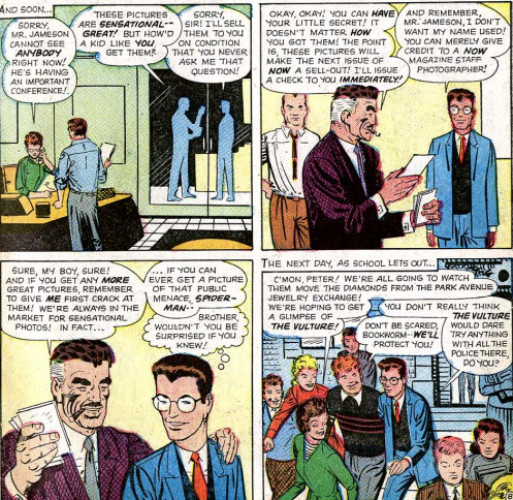
All these details point to Lee and Ditko’s burgeoning, ever-shifting perception of who the Spider-Man character is and will be. There’s no set storyline, no master plan to continue the character’s adventures for decades upon decades at this point. I couldn’t tell you if Peter’s photographic pursuits were intended to be temporary, like a part-time high school job. The Tinkerer story sees Peter help out a professor for an afternoon, and all spontaneous Spidey interruptions aside, he’s engaged in work more in his wheelhouse. Was this originally slated as Peter’s passion, occasionally aiding local professors and scientists? The photography does carry some sentimental weight, the camera having been Uncle Ben’s and all, and it does allow Peter to make a quick buck off his Spidey adventures. But it does make me curious as to Lee and Ditko’s projection for their protagonist–who did they imagine Peter becoming? And how did that notion change during their collaboration?
We do get some concrete details: Peter’s smart, and he’s always been smart. A teacher calls Peter "our top science student." To fight the Vulture, Peter makes a handy dandy anti-magnetic inverter to metaphorically clip the villain;s wings. And, even here, we see the ruse Peter needs to play to become his crime fighting alter ego. Slinking away from a crowd, Peter is spotted by Flash, who taunts the high school hero ("Guess the excitement is too much for his delicate little self!"). As an amusing aside, Peter’s not afraid of some self-referential commentary, mentioning in a moment of victory how his spider-strength "hasn’t let me down yet!" and calling the Tinkerer "one of the greatest menaces I’ve ever faced!" Buddy, it’s your second issue…you fought a burglar and a Russian spy before this…chill out a bit, alright? But it shows Lee and Ditko have ideas percolating through the story: you can easily see the difference between Peter and his alter ego, the shy loner who slips away to become the more confident superhero.
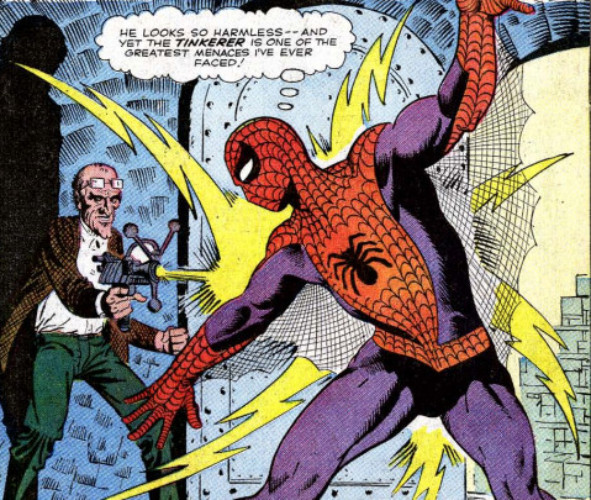
I don’t know the exact distribution of work between Lee and Ditko for this issue. I know, eventually, Ditko took charge of most of the plotting as well as the art, leaving Lee to craft the dialogue. At this stage, however, their storytelling contributions may have been different, maybe split more evenly between both creatives. We can certainly lay the dialogue at Lee’s feet; as is typical, his sentences are bombastic and exposition-driven. "You fool! You jarred my arm! I-I’ve destroyed the control panel!" an alien ally of the Tinkerer’s shrieks as we can clearly tell his foolish friend has jarred his arm, leading to his bumping into and destroying the control panel. Stuff like that abounds.
So Lee’s joking and quipping isn’t exactly brilliant (a cop asking a downed Vulture, "What happened, fella? Did you have a tailspin?" may be the best joke the issue has to offer), but we do get a few standout narrative beats. A very clever moment sees the Vulture, who’s threatened to steal a diamond shipment "from under [the police’s] noses," emerge from a sewer manhole to take the diamonds while security is preoccupied with the skies. The Tinkerer is revealed to be an alien himself (and, yes, I know this got retconned later, but not in 1963) in an amusing twist to end the issue. Spidey uses his incredible strength to free himself from a water tower. Little bits like this help elevate the issue. It doesn’t necessarily matter who was responsible for these moments–who cares if it was Lee or Ditko who wanted the Tinkerer to actually be an alien?–but they help the plots.

Later writers would offer the Vulture deeper characterization (I’m thinking of Mark Millar’s Marvel Knights run where he revealed Toomes has a cancer-stricken grandson), but his base characterization remains fairly solid: he’s a wrinkly, bald dude preying on riches. He steals bonds and diamonds from unsuspecting victims. He hides in the loft of a silo. He’s not given some long-running mystery like the Green Goblin or even a real name at this point; he ends the issue swearing vague revenge on Spider-Man, but aside from that, we don’t get much insight into his motivations. But it’s not necessary. He can fly, and by flying, he challenges Spidey for mastery of the skies. There’s more visual than philosophical heft to this bird-brained bad guy.
The same goes for the Tinkerer. We don’t learn much about him at all other than he’s a grinning gremlin (He looks like a character straight out of Grimm’s Fairy Tales! Pete thinks upon meeting him) aligned with little green guys. But he works precisely because of his longevity. The Tinkerer has, surprisingly, played a larger role in the Spidey mythos than some may deem likely, but he’s stuck around. And the same can be said of Adrian Toomes; he’s remained one of Spidey’s staple adversaries throughout sixty years of comics. There’s nothing much here that points to any good reason for his longevity, but the seeds are planted in this issue.

So enjoy this issue in hindsight: remember it for what it gives us, even if its gifts are malleable. Maybe the Vulture became more than an old coot who stole things, maybe the Tinkerer was retconned into not being an alien after all, maybe Flash was called "Moose" at one point and JJJ used to publish a magazine not called The Daily Bugle. This is just the second Amazing Spider-Man issue after all. Much like our carrion-craving criminal, shouldn’t this issue be allowed to take us by surprise under our very noses?